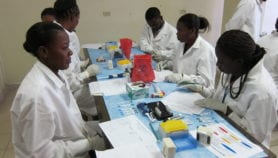By: Ehsan Masood
Send to a friend
The details you provide on this page will not be used to send unsolicited email, and will not be sold to a 3rd party. See privacy policy.
The publication of research papers by scientists in the Middle East is rising steadily, with smaller countries making some of the biggest leaps, according to research from the magazine Science Watch, which compiles information on trends in world science.
The data shows Iran is the pick of the region. Its annual scientific output trebled from about 500 papers in 1996 to more than 1,800 in 2002. Egypt also maintained its upward trend by increasing publications from 2,000 to 2,500 during the same period.
But even as the Arab world’s largest producer of research, Egypt is dwarfed by neighbouring Israel, which produced 157,000 papers in the past 20 years compared with 39,000 for Egypt.
The region’s smaller countries have also chalked up some notable gains. Oman, for example, rose from zero to 236 papers in the past two decades. Jordan has recorded a nine-fold increase to 485 papers in the same period. And Lebanon, which saw scientific output fall during the years of its civil war in the 1980s and early 90s, has produced more than 300 papers in each of the past two years.
The publishers of Science Watch suggest that modest increases in spending on research and development (R&D) in Arab states during the 1990s may be paying off for many of the region’s countries. Data from the United Nations Educational, Scientific and Cultural Organisation (UNESCO) shows that with the exception of Iraq, all Arab states are increasing their spending on R&D despite experiencing declining national incomes due to falling oil revenues.
Saudi Arabia, however, has seen a decrease in research publications from a peak of more than 1,500 in 1996 to 1,300 papers per year since 2000. This fall comes despite a 50 per cent increase in R&D spending between 1992 and 1996 — the latest period for which figures are available.
Nader Fergany, director of the Al Mishkat policy research centre in Cairo, says the decline could be attributed to a reduction in the country’s expatriate scientists. Saudi Arabia’s policymakers are keen to indigenise research, partly by replacing retiring experienced foreign scientists with less experienced, but locally trained ones.
Fergany is also a co-author of the recently published Arab Human Development Report. The report predicts that research and knowledge production are unlikely to flourish while Arab countries remain closed to new thinking, democracy, women’s rights and freedom of speech (see Science communication needs updated Arabic)
But Fergany says the Science Watch data does not contradict his own findings. “We say in our report that knowledge production in the exact sciences does take place in relatively closed societies. But we say this is not sustainable in the long run. Just look at the Soviet Union and now Iraq. Both had considerable R&D. But look at where they are now.”
Some say the increases are too little too late. Omar Bizri, head of technology for the UN’s regional office for Western Asia in Beirut, for example, argues that while the overall trend is positive, the relatively low level of scientific activity in Arab countries compared to the world average remains a cause for concern.
“These countries face many problems on many fronts,” he says. “There is an acute need to create employment for exploding numbers of young people. For this we need to be more competitive. And to be more competitive, we need to be much, much more innovative. That is simply not happening.”













